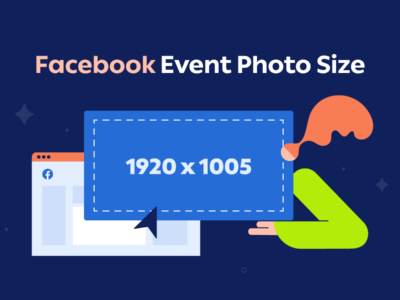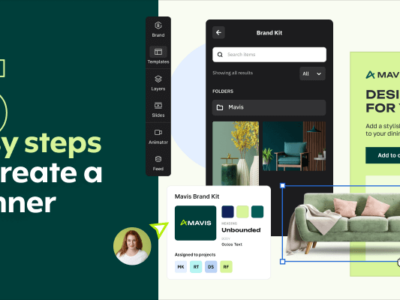You’ve probably heard about how powerful video ads are and how they can benefit your marketing strategy.
But how do you begin to leverage video advertising?
Look no further because this video marketing guide covers the ABCDs of video advertising, so it’s perfect for getting you started. You’ll learn what this type of online advertising implies, discover the most popular video ad types and see how they connect to your marketing goals, but also how to create video ads and measure campaign success.
If you stick until the end, you’re in for a treat—several video advertising examples from well-known brands to inspire you.
Summary
1. What Is Video Advertising?
2. Video Ad Types
3. What Are the Benefits/Advantages of Using Video Ads? (The Why)
4. Digital Video Advertising – Best Practices
5. Display vs. Video Advertising
6. What Type of Marketing KPIs Is Video Advertising Suited For?
7. What Makes a Good Video Ad?
8. Video Ads – Technical Specs
9. How to Create Video Ads
10. What Are Native Video Ads?
11. How Do Video Ads Get Placed Online?
12. Video Advertising Effectiveness and How to Measure It
13. Video Ad Examples
1. What Is Video Advertising?
Video advertising refers to the promotion of products or services through short video content, with the purpose of driving awareness and ultimately encouraging sales.
Video ads are usually delivered either within streaming content or before and after it, but they can also be displayed outside said content.
Marketers’ opinions are divided when it comes to defining online video advertising, as some include display ads as well, more specifically video display ads, and even rich media ads/animated ads, while others don’t. There is an overlap between them so it’s difficult to draw a clear line.
Throughout this article, when we talk about video advertising, we refer to all types of ads classified as video content, regardless of whether or not they can also be defined as display ads.
Video advertising is an increasingly popular way to reach online audiences. According to a recent survey conducted by wyzowl, 92% of marketers consider video ads to be a big part of their marketing strategy. Looking at data from eight years back, it’s clear this type of advertising follows an ascending curve in terms of popularity.
Moreover, 73% of participants said they’d rather watch a short video than consume other types of content such as blog articles or social media written posts, infographics, ebooks, and so on.
2. Video Ad Types
There are many video ad types, so you can choose what best suits your message at any given time or include multiple variations in the same campaign.
Below you can find a fairly simple enumeration of the main types of ads available. We didn’t go into many details as this guide is created with beginners in mind, but the information we provided should help you get started.
With that being said, here are the ad types you should be familiar with when advertising through video:
2.1. In-stream ads
This is probably the first ad type that comes to mind when thinking about video advertising. If I had to guess why I would say it’s probably because of their disruptive nature.
In-stream video ads, also known as linear ads, are delivered within video streaming content, either pre-roll, mid-roll or post-roll, so they make quite an impression on us.
They are skippable if longer than 15 seconds or non-skippable if under 15 seconds. For instance, YouTube bumper ads are unskippable because they have a maximum length of six seconds.
Surely you’ve come across both types of in-stream ads while watching content from your favorite YouTube creators. When ads are skippable, a “Skip Ads” button appears in the bottom right corner of the player. If you don’t have the option to skip the ad, you’ll see a countdown to the ad’s end instead.
There is a limited number of websites that allow in-stream ads, but giants like YouTube and Facebook are on this list, so the pool of online users you can reach is large enough.
2.2. Out-stream video ads
Unlike in-stream ads, out-stream ones are not connected to other video content.
They typically appear on mobile or tablets when browsing different websites and play automatically on mute. You can pause them with a simple click or by scrolling past.
There’s a big chance you’ve already encountered out-stream video ads while reading an article on news websites, or browsing on e-commerce websites.
Although some marketers include video ad placements within social media feeds in this category, they are not usually classified as out-stream ads, which leads me to the next type of ads.
2.3. Native video ads
These are ads that look like the content they are placed within, which is what makes them stand out from the other ad types on this list and commands more attention from users.
They are generally labeled as sponsored or paid, which is the main revealing sign you are watching an ad as opposed to organic content.
We’ll go into more details about native video advertising in one of the following chapters.
2.4. Rewarded video ads
These ads prompt app users to watch a video in exchange for different rewards and offer an immersive experience due to taking full-screen.
They are known to be quite high-performing with 62% of mobile game players engaging with rewarded video ads on a regular basis.
Imagine you are playing a mobile game where you have numbered lives. It is rather frustrating having to exit simply because you have gone through all of them.
Enter rewarded ads. You will probably be inclined to watch a short ad if that means you can go back to playing the game.
Although most frequently encountered in games, rewarded ads are not exclusive to mobile gaming and can be used in other mobile apps as well.
Another great thing about rewarded ads is that users usually have the option to opt in or opt out, but they cannot skip the ad once it starts.
2.5. Shoppable video ads
Shoppable ads are part of an emerging trend and entail brands adding product feeds to their video ads so viewers can find out more about the promoted products without leaving the video.
Clickable overlays with product pictures and brief information are more likely to turn views into conversions rather than plain video content because they make it easier for users to reach the purchase point.
You can use this type of video advertisement in a variety of placements, including social media and display ads. If you want to take a step further, you can integrate shoppable videos on your website’s landing pages to drive conversions.
3. What Are the Benefits/Advantages of Using Video Ads? (The WHY)
This is the paragraph for you if you need convincing about whether to venture into online video advertising.
But this is not the only reason you should read this part.
By being familiar with all the advantages video ads come with, you will be able to use them to their full potential and reap more rewards than you would by having a superficial knowledge of the topic.
Here’s what makes video ads worthy of being part of your marketing mix:
Condensed format
There’s only so much information that you can convey through text or image ads, but it’s a whole different story when it comes to video.
Depending on the frame rate of your video, meaning the speed at which composing images succeed one another, you can fit from 24 to over 60 images per second. While 24fps is the most common one, some publishing platforms have their own requirements regarding ratio. Still, the point is video provides more room for effective storytelling.
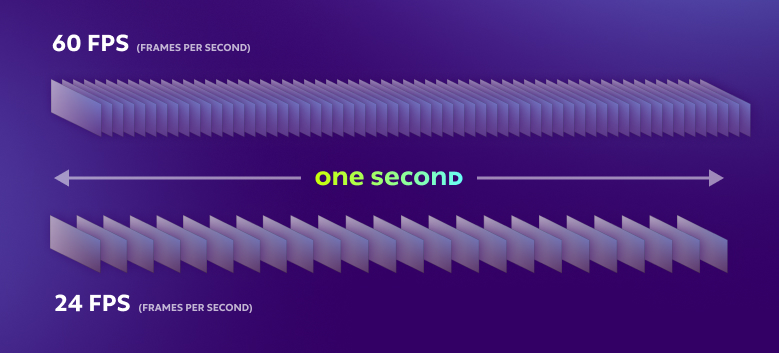
Plus, dynamic content can have a more significant emotional impact on the viewer because it engages both visual and auditory senses. Definitely your best chance if you want to encourage engagement and tug at viewers’ heartstrings.
Extensive reach
Recent findings reveal that people watch an average of 19 hours of online video content each week. This marks a one-hour increase from last year and an 8.5-hour growth compared to four years ago.
In fact, we’re watching more videos than ever before. Pretty surreal, right? But I think it’s safe to assume that online video consumption will stay on an ascending path and continue to grow in the following years.
Since video content draws large numbers of people in, incorporating video ads into your marketing strategy will help you reach a wider audience and increase brand awareness, differentiating yourself in a crowded marketplace.
Cost-effective
For a while, many brands were afraid to dip their toes into video advertising waters because that meant a large part of their marketing budget would go to filming and editing. But things have changed, and the perception that video is expensive is no longer valid.
On the contrary, it has become easier to create in-house and is accessible to pretty much anyone. Even the less experienced members of your team can create video ads with the right tool.
For instance, in Creatopy, you can easily make professional-looking video ads in a drag and drop editor, using premium stock content or your uploaded footage, with little to no design skills required.
Highly shareable
Video content hooks people in, and more often than not, users want to share interesting videos with friends and acquaintances or repost them on their favorite social media channels for their virtual community to see.
But sharing can happen outside of social media too, via email or through embed codes on other websites.
This is great news for your brand awareness because if your video ads are shareable material, your exposure will grow exponentially, and you will reach more people than initially planned.

Just imagine that someone with tens of thousands of followers organically shared your video ad just because it provides value. It would give your brand’s visibility a significant boost.
Favored by search engines
It’s not only sales that video ads can help you improve, but SEO ranking as well.
Rumor has it that Google prioritizes search results with video content, so embedding video ads on landing pages or posting them on your blog can give your website major SEO juice.
Uploading and listing your ads on YouTube will also increase the chances of your audience discovering them during Google queries. Of course, you must also optimize them to ensure they get high placements on search result pages.
Suitable for educative purposes
Video is at the crossroads of audio and visual, which makes it an effective tool to teach people about your product or service. Similarly, training video software has become an indispensable tool for educational and corporate settings, offering a dynamic way to deliver instructional content.
You can show and tell at the same time, appealing to both visual learners, who learn by seeing things or reading about them, and auditory learners who learn by hearing about something.
For example, if your ad must include a how-to component that teaches people to use your product or service, then choosing to do in video advertising is your best choice. You can also add subtitles to the ad in such scenarios to ensure no information is lost on the users.
Great return on investment
What’s the point of investing in ads if they don’t deliver ROI? Well, there is none. Luckily, most advertisers agree on the fact that video ads bring strong results.
In fact, 81% of marketers state video has led to increased sales. And it’s not just marketers that testify to the effectiveness of video advertising. On the receiving end of promotional efforts, 88% of customers say that video has been a key factor in their purchase decisions.
Video is more effective than other advertising formats in driving acquisition and, by extension, increasing revenue. This probably isn’t news to you if you’ve used video ads as well as text and image ads and compared results.
4. Digital Video Advertising – Best Practices
It’s true video ads can persuade your audience to purchase, but you must be aware success is not guaranteed.
However, if you follow a set of practices deemed more effective at an industry level, your chances of harnessing the power of video will increase.
Here are the most important guidelines your ads should follow in order to maximize your chances of getting ROI.
4.1. Grab attention within the first three seconds
If you manage to captivate users in the first few seconds, they are more likely to watch your ad until the end. Start on a high note and then adjust the narrative structure of the video to keep viewers’ attention along the way.
You can open with an intriguing question, a baffling statistic, a bold statement, or any other strong piece of content that fits your advertising purpose. Check out this great intro from monday.com that has all the chances of convincing Facebook users to click the play button.

Visually there are a number of artifices you can use, including bright colors and high-contrast combinations, large-size typefaces, or design elements that fit your brand’s personality.
As far as pace is concerned, set a fast pace in the beginning to captivate your audience. You can slow it down as the story unfolds, or keep the speed up throughout the whole video if you’re aiming for an upbeat ad.
4.2. Showcase your brand or product early on
Let’s face it, most users don’t want to watch video ads so they turn them off whenever they get the chance.
This is why you should mention your brand or product before they decide to push the skip ad button, scroll past the ad or click on the little x that closes the window. We’re talking seconds here.

Google writes that placing a brand logo or mentioning the brand name within the first five seconds of an YouTube ad is a double-edged sword. While it may boost brand awareness, it can also prompt viewers to hit skip.
Still, it’s a risk worth taking. Even if they exit the ad afterward, there is a chance they might remember your brand at the appropriate time, i.e., when they need the type of product or service you sell.
4.3. Make sure it works with sound off
Picture this: you’re commuting to work, and while on the subway, you take out your phone and start scrolling through your platform of choice. An interesting video comes up, but you forgot your earbuds at home, so you watch it on mute.
Sounds familiar, right? That’s because most of us watch videos on mute while in public places.
As a marketer, you must create ads with this in mind and ensure your promotional content is just as effective without sound.
For this purpose, you can use suggestive text and graphics when editing the video or add captions to the finished ad.
See how Notion used text to get their message across, leaving audio to be a nice addition rather than a must.

4.4. Include at least one call to action
Whether it’s buying your product, signing up for a free trial, or simply visiting your website, you want users to know exactly what they need to do next.
To make sure it’s easy for them to take action by the end of the video, give them clear instructions in the form of an appealing call to action.
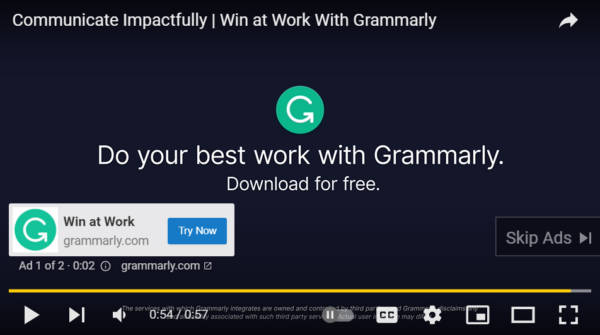
Many users won’t be around to hear the CTA you end with, so it’s best to include others besides that one. It’s up to you how simple, or complex the call to actions you chose are, as long as they convey the right message.
4.5. Optimize for mobile
There are 6.4 smartphone users in the world, which makes up approximately 80% of the global population, which means mobile-optimized ads increase your chances of getting your brand in front of the right people.
How do you appeal to mobile viewers? Prioritize vertical (9:16) or square videos (1:1) over landscape ones (16:9) whenever possible. People usually hold their phones vertically, and these two rations cover more space on the mobile screen, offering a better experience.
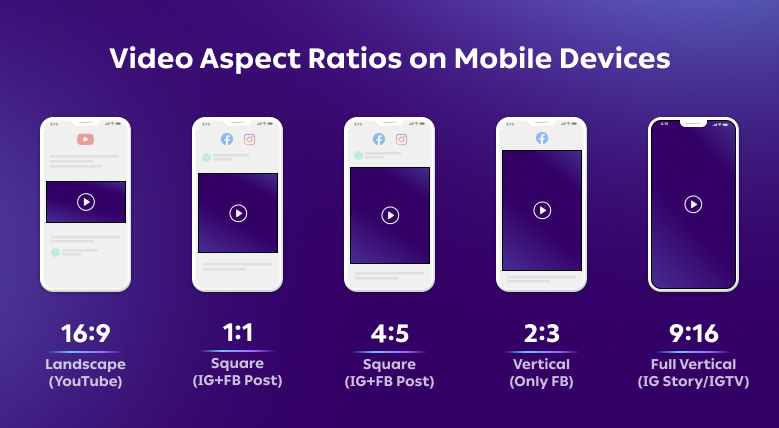
Next to ratio, font size is equally important. Your text should be large enough to be easily readable on mobile devices.
Preview your ads on as mobile screen dimensions as possible, from largest to smallest. Only by testing before publishing will you know for sure if your ad is truly mobile-friendly.
5. Display vs. Video Advertising
As I’ve mentioned in the beginning, there is an overlap between video and display advertising, as some video ads can be categorized as display ads as well.
So, when making this comparison, we refer to display ads as ads that have non-video content, such as image ads or text ads.
If you’ve used them before, then you already know display ads allow you to target online audiences with high accuracy, but they are prone to be ignored by users due to a phenomenon called banner blindness.
On the other hand, video ads are less likely to be disregarded, as they are much more engaging as a result of their dynamic nature. This is also why oftentimes video ads are much more effective than display ads.
If you are unsure whether to favor display ads or video ads for your marketing strategy, here is a side-by-side comparison of the two.
| Display ads | Video ads |
| Easily ignored | Extremely engaging |
| Lower CTR | Higher CTR |
| Deliver a message | Deliver a narrative |
| Less memorable | More memorable |
| Non-shareable material | Shareable material |
| Higher CPC | Lower CPC |
6. What Type of Marketing KPIs Is Video Advertising Suited For?
KPIs (key performance indicators) are metrics that can help you measure the progress of your marketing efforts and show you what adjustments you need to make in order to get closer to your marketing goals.
Generally speaking, you need to set goals for every video ads campaign and then track matching metrics for each of them.
It can seem daunting if you’re new to this but trust me, all you need to do is study your target audience and think about what you want to achieve.
Besides, ad publishing networks like Google and Facebook give you a list of goals and associated KPIs you can choose from when setting up your campaign.
Since it’s impossible to talk about one without the other, below you can find the most popular marketing goals video advertising is suited for and their corresponding KPIs.
Brand awareness
This top-of-the-funnel marketing goal is focused on getting your target audience familiarized with your brand. To achieve this, you want to track impressions, views, and unique views of your videos.
Website traffic
As the name suggests, this goal refers to driving traffic to your website. It requires you to keep an eye on clicks on website links from your video ads and check the percentage of new website visitors.
Build purchase intent
Moving mid-funnel, you must try to build purchase intent, also known as drive consideration. If you’ve chosen this goal, you must focus on KPIs like watching time and completion rate but also be mindful of the time users spend on your website.
Lead generation
Further down the funnel, you can encourage potential customers to take action in the form of sign-ups, app installs, and even conversions, all of which are measurable KPIs as well. Remember to also track cost per lead to see how much you pay for each customer performing a specific action.
Sales growth
If your goal is to increase revenue through sales, you should track KPIs related to purchases attributed to an ad such as the number of purchases that come from a specific video link or the average amount spent.
There are other marketing KPIs that you should track but these are the most frequently used with this type of advertising and we’ll take a closer look at them in one of the following chapters.
7. What Makes a Good Video Ad?
It can be summed up in a single word: storytelling. The most successful video ads out there are also compelling stories that create interest and engage the viewer.
Storytelling not only provides a structure for creativity but it can also help you foster a connection with your audience. Plus, it makes the message you convey much more memorable.
Think of your video ad as a much shorter film. You can go the comedy route to get a few good laughs from your audience, rely on drama to provoke an emotional reaction, or use animation to showcase your brand’s fun and friendly nature.
Whichever you choose, the main idea is to make the story as captivating as you would in filmmaking. Remember to align the themes and narrative elements with your brand’s values to help your customers understand what you stand for.
Take a look at this Sainsbury’s advert. Besides the fact that it’s nothing short of an animated Hollywood production, it has all the characteristics of a good story. Engaging? Check. Memorable? Check. Raises strong emotions? Check.
While good stories need space to unfold and are most suitable for lengthy video ad types like the TV commercial above, it’s possible to tell a story in shorter ads if you manage to grab viewers’ attention quickly.
In fact, with digital video advertising, it’s recommended that you keep it short and sweet to get your message across before users click away. But don’t let that frighten you. I mean, if this Mercedes-Benz ad can do it in three seconds, then so can you.
8. Video Ads – Technical Specs
The most important technical aspect of video ads is length because it can influence how much of your ad viewers will watch. A longer duration usually means users get bored and hit skip or turn off the ad in some other way.
Since brands want to avoid skips, the industry standard for video ad length is around 15 seconds. However, each publishing platform has its own recommendations.
For example, Google is quite permissive with its suggested length for skippable in-stream ads, advising advertisers to keep videos under three minutes.
Still, their non-skippable ads are capped at 15 or 20 seconds, depending on the region of upload, which complies with the industry standard length.
Of course, brands also publish shorter ads, especially for the bumper ads format that has a length of six seconds, but also for skippable ads that users can choose to skip after five seconds.
On the other hand, Meta advises keeping mobile video ads at a maximum of 15 seconds even though they have placements that support longer videos on both Facebook and Instagram.
LinkedIn also says that the most successful video ads on their platform are under 15 seconds.
Another specification you should consider when making and delivering video ads is file size. Luckily most advertising and social media platforms provide either a range or a maximum file size in this direction.
These differ from one platform to another. For instance, Google allows video ad uploads of up to 1GB and Pinterest up to 2GB, while LinkedIn technical requirements mention video ads file sizes should be between 75 KB and 200 MB.
The same applies to file type—each platform sets its own formats. The most common ones are MP4 and MOV, but GIF or M4V files are also allowed on certain platforms.
Frame rate may not be on your radar, but it’s definitely a requirement you should also take into consideration, as a number of platforms require specific video frame rates.
9. How to Create Video Ads
So, we’ve reached the practical part.
By now, you should have chosen a marketing goal and decided on the type of video ads you want to create.
As I previously mentioned, nowadays, it’s very easy to make video ads in-house. In fact, keeping ad creation in-house is more efficient and cost-effective than outsourcing it. However, this is not always possible, at least not fully.
If you want to make your own video ads but don’t know exactly how to go about it, the steps below will put you on the right path.
9.1. Decide on the video style and publishing network
When making this decision you should think about your brand and what type of video is most suitable for it and the message you’d like to convey. Equally important is what would appeal to your target audience and where is your video most likely to reach said audience.
There are many different video styles to choose from, including live-action, animated, motion graphics, and typography videos, to name a few.
Besides being the place where your audience reunites, the publishing platform also dictates technical specifications for your video such as length, file format, ratio, so keep that in mind when selecting it.
Don’t forget to also take your budget into consideration as some styles may be more expensive to make than others. For instance, typography videos will not put a strain on your budget, while animation ones might.
9.2. Devise a plan of action
Depending on the style of video you’re set on, your course of action may be slightly different. Still, most videos require a written script beforehand.
Once you’ve got that ready, the next step is to establish how you will prepare your video content.
For live action it is possible to do it in house If you have the necessary equipment to film. DSLR cameras will result in the best quality, but you can also film with smartphones or tablets.
Animation and motion graphics call for graphic designers and animators to get involved in the process and if you don’t have any on your team, you need to outsource the work.
Yet, if you want to keep ad editing in-house you should choose an editing tool such as Creatopy’s video editor, which has a short learning curve and can be used by anyone, regardless of their skill level.
9.3. Film, animate or find stock footage
This step is pretty self-explanatory. All you need to do is follow your previously devised plan and create the content you need for your video ad.
Alternatively, you can rely solely on stock content to make the ad. This option is not only easier, but also more cost-effective than the alternative.
In Creatopy, you have an extensive Shutterstock premium stock library of high-quality videos or photos, so the chances of finding footage that fits your brand and message are very high.
9.4. Start editing
Open your editing software or go on your chosen online video editor and piece together live-action footage/animation with sound and smooth transitions to get your message across.
Don’t forget to add design elements like brand colors, fonts, or logos to increase brand awareness. Creatopy’s brand alignment feature can help you do this with little effort. You simply have to organize all brand assets into a brand kit that you or any team member from your team can access from the workspace while editing video ads.
9.5. Export your ads
Once you’re satisfied with how your ad turned out, export it in a format that complies with your publishing platform’s requirements.
If you’ve done your editing in a video editing software like Final Cut Pro, exporting your video is preceded by the hardware-demanding processes of rendering.
With online editing, the export process is shorter and you can run it in the background as it takes place on the platform’s servers and does not take up many of your computer’s resources. Creatopy even notifies you via email when your video ads are ready to download.
10. What Are Native Video Ads?
Out of all video ad types out there, native video ads are the ones that feel least like ads. This is because they blend in seamlessly with existing content without disrupting the user experience.
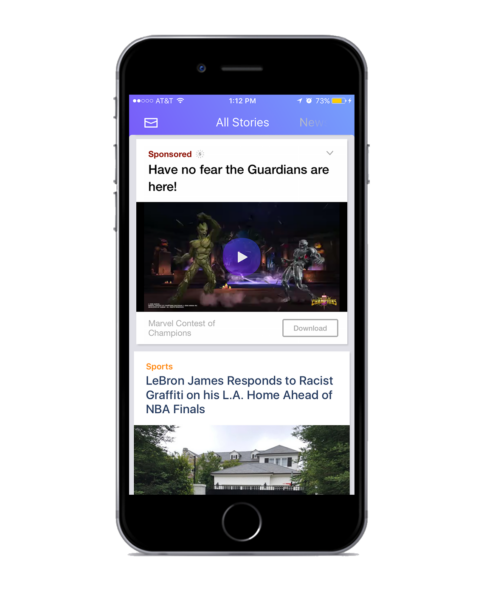
Common examples of native video ads are in-feed ones encountered on social media platforms like Facebook, Instagram, or Pinterest, but they are also present on streaming platforms like YouTube.
Native video ads can be either click to play or autoplay as users scroll through feeds, with length requirements varying from one publishing network to another.
Due to the unique capability to integrate so well with their surroundings, native video ads generally perform better than other types of video ads and can positively impact the audience’s perception of your brand, according to recent research.
They also inspire more engagement, especially on Facebook where they can generate up to eight times more comments, as proved by this study performed by Quintly.
11. How Do Video Ads Get Placed Online?
There are two main ways to distribute video ads on the internet.
The first and most well-known implies downloading video ad files from the editing platform or software you used to create them and uploading them manually on the publishing platform. It’s a pretty straightforward process, but it is time-consuming and requires you to pay attention to technical details like file size, format, and so on.
The second one is automated and more complex, though it isn’t much different from display ad serving.
Video serving is done with the help of demand-side platforms (DSP), where advertisers can set up campaigns and corresponding KPIs and have the platform bid for ad inventory to various publishing networks in real-time.
When a user accesses an ad publishing platform where the bid was accepted, a request is sent to the DSP to retrieve the ad and display it.
This is done through a tag named video ad serving template (VAST), which is a piece of code that lets the ad server know how the ad must be delivered.
It’s a much more convenient way of serving video ads, and it allows you to track ad performance just as efficiently.
12. Video Advertising Effectiveness and How to Measure It
Your work isn’t done when you’ve put your ads into the world, quite far from it. If you want your campaign to be effective and bring the ROI you’re hoping for, you need to measure its performance along the way and make tweaks if needed.
This is where KPIs come into play. Knowing what metrics to look at will help you optimize your campaign and set it on the right track.
Here are the most frequently tracked performance indicators for a video ad campaign:
12.1. Impressions
Impressions indicate the total number of times your video ad comes up on someone’s screen, regardless of whether they skip or close the ad immediately after.
For click-to-play ads, an impression is registered when someone sees the ad thumbnail on a computer, tablet, or mobile device without clicking it.
Impressions on their own don’t say that much about performance, as your video ad can appear to a large number of users only to be ignored or quickly closed, but they are essential to calculating other KPIs such as VTR and CTR.
12.2. Views
Views show the total number of users that watch a designated amount of your ad.
The watching time it takes for a view to be registered differs from one platform to another and can also vary depending on ad duration.
For YouTube in-stream ads, a view is counted when someone watches a video to completion if it is under 30 seconds, or the user watches a minimum of 30 seconds if it is longer than that.
On Facebook and Instagram, someone needs to watch your ad for three seconds or more for it to count as a view. For Twitter, the mark is two seconds but the video player needs to cover 50% of the user’s screen and so on.
12.3. Unique views
It represents the number of unique users that view a certain amount of your ad over a specific time period.
Measuring unique views is done through the controversial cookies, which are one-of-a-kind identifiers in the form of a string of letters and numbers in each user’s web browser.
This is the KPI to track if you want to see how many individuals your ad managed to reach.
12.4. VTR
VTR stands for view-through rate and it gives you the exact percentage of people who watched your ad to completion, without skipping it.
If your ad had 300 impressions (appeared on the screens of 300 people), but only 60 of them watched it till the end, the latter is the metric you would use to calculate VTR. Here’s how to do it:
complete views ÷ total number of impressions = VTR
VTR is worth tracking as it lets you know precisely how successful your efforts of engaging users are.
12.5. CTR
CTR stands for click-through rate, which measures the percentage of people that click on links from your ad.
Of course, you want as many people as possible to end up on your website or app, so if the CTR is low, you must make adjustments like changing the call to action to make it more appealing.
This is how to calculate this metric:
total number of clicks ÷ total number of impressions × 100 = CTR
For example, if you get 1,000 clicks from 50,000 impressions, your CTR is 2%.
12.6. Conversion Rate
A conversion could be anything from clicks, to sign-ups, to sales, depending on the action you want customers to take when watching your ad.
High conversion rates are the ultimate indicator of a successful video campaign, while low ones reveal your ads are not as effective in turning viewers into leads or customers.
Still, low conversion rates might point out you need to optimize your website for conversions by changing the landing page users end up on, for example.
Here’s how you can calculate this metric:
total number of conversions ÷ total number of views from the same period of time × 100 = CR
Imagine you have 20 conversions from 1000 views. 20 divided by 1,000 results in a 2% conversion rate.
12.7. Watch time
This KPI measures how much time people spend watching your ad. The amount is measured in seconds or minutes and it’s added cumulatively, meaning it also includes replays.
You can use it as a reference to compare different ads or different campaigns and discover the reasons why some might perform better than others.
Not only can it point out the most effective ads in capturing your audience’s attention, but by giving you insight into how users engage with your ads, it can help you improve the way you create ads in the future.
13. Video Ad Examples
Theory feels insufficient when it’s not accompanied by a few relevant examples, so this chapter aims to illustrate what we’ve discussed so far through great video ads from popular brands.
Check them out to get inspired for your future video ad campaign. Even if it isn’t your first one, and you’ve got some experience under your belt, you’ll surely learn a thing or two from these ads.
Where there’s Asana, there’s a way
For those of you who are not familiar with the product, Asana is a work management platform that teams of professionals use to organize, track, and manage tasks.
This video ad cleverly uses the split screen technique to portray office workers’ life pre and post-pandemic. It is extremely relatable as a large part of the viewers experienced working from home during this time.
The product works as a bridge between the two realities, helping employees stay organized even when working from home, amongst energetic children and attention-seeking pets.
Oreo meets the Batman
You’ve probably heard of the newest Batman adaptation that just hit theaters since it inspired countless memes and received critical acclaim.
Apparently, so has Oreo. The brand created a limited edition pack of their creme-filled cookies to match the famous superhero’s style.
If you’re a DC fan and you’ve got a sweet tooth, you probably already grabbed a pack of these limited edition Oreos. If not, this ad that recreates Batman scenes using Oreo cookies will most likely convince you to run to the nearest supermarket.
Twitter Blue is a workout
I don’t know about you, but I love the 80’s aesthetic. I can’t think of anything else that manages to be both tacky and cool at the same time, so this ad reminiscent of an aerobic tape hits the mark for me.
Twitter found an innovative way of introducing its first subscription-based service called Twitter Blue, targeted at people who spend a lot of time on the platform.
The analogy between avid Twitter users and workout enthusiasts is a match made in heaven and gives the video that funny touch that makes it worth watching to completion.
See toys everywhere
Most of us are nostalgic for our childhoods when we looked at things with curious eyes and open minds, frequently letting our imaginations take control.
The toy company Fisher-Price taps into this feeling with this heartwarming video ad narrated by a kid describing what he sees when he looks at household and personal items, as we rediscover what they may represent during child play.
It’s effective because it appeals to our emotions, making it easy to remember the brand next time when looking to buy toys.
Now you see me, now you don’t
Diversity in advertising is a real issue and No. 7 cosmetics and skincare brand acknowledges this in their video ad, making a case for their product that works on all skin shades, plus aging complexions and uneven pigmentation.
By tackling such a sensitive topic, the video ad grabs attention from the get-go and uses its narrative structure to hook the audience up until the product reveal.
Keep it going with Goodwill
This Goodwill animated video ad promotes a sustainable approach to fashion and encourages viewers to donate used clothes instead of throwing them away.
The dynamic animation style and the upbeat pace of the ad draw users in instantly, while the message is conveyed effectively in just 30 seconds. Moreover, the brand makes a point of giving back to the community, polishing its good image.
The video ends with the straightforward CTA “Donate something this weekend, and let’s keep it going!” hints at the longevity of a clothing item if donated to Goodwill.
Duolingo makes it fun
Give it to Duolingo to turn both language learning and ad making into something fun.
The lyrics of this ad’s catchy song perfectly describe the struggle of learning new languages (the problem) and how Duolingo (the solution) can help you conquer it.
This colorful and engaging ad is right on brand, featuring characters from the Duolingo app, and let’s face it, you’re going to hum this jingle for days to come. I know I did.
Something better for your dog
This ad presents us with a Cast Away-like scenario that makes you think twice about replying with “my dog” when asked “What would you take to a deserted island?”
It is short and funny, managing to hold the best for last so as to avoid skips. Dog owners are very likely to engage with the ad. Even I feel tempted to and I am not in Greenies’ target audience.
Although it doesn’t end with a CTA, but a statement, the choice of words places Greenies as something better for dogs to chew on than sticks. Even when your rescue from an island doesn’t depend on it.
Wrapping Up
Video ads can only improve your marketing strategy, regardless of the size of your business or the industry you activate in. It’s only a matter of you deciding whether you want to give them a chance. If you do, we hope this guide will make your plunge into online video advertising much easier.
Let us know which part of this video marketing guide you found most helpful, and feel free to share your first experience with video ads down below.


